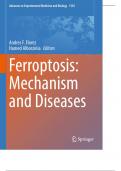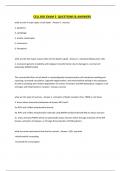Advances in Experimental Medicine and Biology 1301
Andres F. Florez
Hamed Alborzinia Editors
Ferroptosis:
Mechanism
and Diseases
,Advances in Experimental Medicine
and Biology
Volume 1301
Series Editors
Wim E. Crusio, Institut de Neurosciences Cognitives et Intégratives
d’Aquitaine, CNRS and University of Bordeaux UMR 5287,
Pessac Cedex, France
Haidong Dong, Departments of Urology and Immunology,
Mayo Clinic, Rochester, MN, USA
John D. Lambris, University of Pennsylvania, Philadelphia, Pennsylvania, USA
Heinfried H. Radeke, Institute of Pharmacology & Toxicology, Clinic of the
Goethe University Frankfurt Main, Frankfurt am Main, Hessen, Germany
Nima Rezaei, Research Center for Immunodeficiencies, Children’s Medical
Center, Tehran University of Medical Sciences, Tehran, Iran
Ortrud Steinlein, LMU University Hospital, Institute of Human Genetics,
Munich, Germany
Junjie Xiao, Cardiac Regeneration and Ageing Lab, Institute of
Cardiovascular Sciences, School of Life Science, Shanghai University,
Shanghai, China
,Advances in Experimental Medicine and Biology provides a platform for
scientific contributions in the main disciplines of the biomedicine and the life
sciences. This series publishes thematic volumes on contemporary research
in the areas of microbiology, immunology, neurosciences, biochemistry,
biomedical engineering, genetics, physiology, and cancer research. Covering
emerging topics and techniques in basic and clinical science, it brings together
clinicians and researchers from various fields.
Advances in Experimental Medicine and Biology has been publishing
exceptional works in the field for over 40 years, and is indexed in SCOPUS,
Medline (PubMed), Journal Citation Reports/Science Edition, Science
Citation Index Expanded (SciSearch, Web of Science), EMBASE, BIOSIS,
Reaxys, EMBiology, the Chemical Abstracts Service (CAS), and Pathway
Studio.
2019 Impact Factor: 2.450 5 Year Impact Factor: 2.324
More information about this series at http://www.springer.com/series/5584
,Andrés F. Florez • Hamed Alborzinia
Editors
Ferroptosis: Mechanism
and Diseases
,Editors
Andrés F. Florez Hamed Alborzinia
Department of Molecular Division of Stem Cells and Cancer
and Cellular Biology German Cancer Research Center
Harvard University (DKFZ) and Heidelberg Institute for
Cambridge, MA, USA Stem Cell Technology and Experimental
Medicine (HI-STEM)
Heidelberg, Germany
ISSN 0065-2598 ISSN 2214-8019 (electronic)
Advances in Experimental Medicine and Biology
ISBN 978-3-030-62025-7 ISBN 978-3-030-62026-4 (eBook)
https://doi.org/10.1007/978-3-030-62026-4
© Springer Nature Switzerland AG 2021
This work is subject to copyright. All rights are reserved by the Publisher, whether the whole or
part of the material is concerned, specifically the rights of translation, reprinting, reuse of
illustrations, recitation, broadcasting, reproduction on microfilms or in any other physical way,
and transmission or information storage and retrieval, electronic adaptation, computer software,
or by similar or dissimilar methodology now known or hereafter developed.
The use of general descriptive names, registered names, trademarks, service marks, etc. in this
publication does not imply, even in the absence of a specific statement, that such names are
exempt from the relevant protective laws and regulations and therefore free for general use.
The publisher, the authors, and the editors are safe to assume that the advice and information in
this book are believed to be true and accurate at the date of publication. Neither the publisher nor
the authors or the editors give a warranty, expressed or implied, with respect to the material
contained herein or for any errors or omissions that may have been made. The publisher remains
neutral with regard to jurisdictional claims in published maps and institutional affiliations.
This Springer imprint is published by the registered company Springer Nature Switzerland AG
The registered company address is: Gewerbestrasse 11, 6330 Cham, Switzerland
,Foreword
Twenty years ago, cell death was a simpler field. Apoptosis was the only cell
death process known to be regulated by a specific biochemical mechanism,
and the induction of apoptosis was thought to explain the vast majority of
programmed and pathological cell death in vivo. But since that time, it has
become abundantly clear that, in addition to apoptosis, cells can die in
response to the activation of several non-apoptotic cell death mechanisms,
including necroptosis, pyroptosis, and ferroptosis. The existence of multiple
distinct non-apoptotic cell death pathways raised innumerable fundamental
questions and may explain the previously surprising observations that, when
examined closely, inactivating the apoptotic machinery does not completely
suppress cell death in development or prevent pathological cell death in vivo.
Ferroptosis is an especially unique cell death mechanism in several ways.
First, as the name implies, and unlike other cell death mechanisms, it is char-
acterized by an essential role for iron – a role that still remains poorly defined.
Second, unlike apoptosis and other known non-apoptotic cell death processes,
ferroptosis is not defined by specific protein effectors. Rather, ferroptosis is
fundamentally a metabolic process, characterized by the iron-dependent
overaccumulation of toxic lipid peroxides. Third, ferroptosis is not an active
process that absolutely requires the transcriptional or post-translational
induction or modification of a specific death effector in response to lethal
stimulation. Rather, ferroptosis has been referred to as a process of cell sabo-
tage, or cellular imbalance, where disruption of the normally active intracel-
lular antioxidant machinery allows for a runaway accumulation of lipid
peroxides through the normal actions of the cell. This biochemical unique-
ness, together with the evident importance of ferroptosis in vivo, has height-
ened interest on how this pathway operates and how this pathway could be
turned on or off in different medical scenarios.
Collectively, the chapters in this book provide a detailed introduction and
overview of ferroptosis and describe recent progress in several important
areas. Pouyssegur and colleagues describe how targeting system x?c may pro-
vide a new therapeutic avenue for the treatment of pancreatic cancer via the
induction of ferroptosis. Venkataramani, as well as Mancias and colleagues,
delves into the still mysterious role of iron in the ferroptotic mechanism, and
how iron storage and recycling pathways play a critical role in governing fer-
roptosis sensitivity and execution. Amaral and Namasivayam discuss the
emerging evidence that ferroptosis has a role to play in infectious disease, a
fact that may be especially surprising given that apoptosis, necroptosis, and
v
,vi Foreword
pyroptosis are already known players in this area. Ferroptosis was initially
described in 2012 using a variety of small molecule tools to activate or inhibit
this process, and as described by Rodriguez and colleagues our ability to
modulate ferroptosis continues to expand in various ways. Finally, as noted
above, ferroptosis is not the only type of non-apoptotic cell death to be
described, and Zanetti and Weinlich describe how necroptosis represents yet
another biochemically distinct pathway. As implied by this final chapter, a
major question awaiting detailed elucidation is how different non-apoptotic
cell death modalities contribute to complex pathological phenotypes in vivo.
This book provides a solid foundation in ferroptosis and other non-apoptotic
cell death pathways and establishes a solid foundation for future studies in
these emerging and important areas.
Department of Biology, Stanford, CA, USA� Scott J. Dixon
August 2020
,Contents
1 ��Ferroptosis: Concepts and Definitions����������������������������������������� 1
Andrés F. Flórez and Hamed Alborzinia
2 ��Overcoming Therapeutic Challenges for Pancreatic
Ductal Adenocarcinoma with xCT Inhibitors ����������������������������� 7
Milica Vucetic, Boutaina Daher, Shamir Cassim, Scott Parks,
and Jacques Pouyssegur
3 ��Iron Homeostasis and Metabolism: Two Sides of a Coin ����������� 25
Vivek Venkataramani
4 ��The Role of NCOA4-Mediated Ferritinophagy
in Ferroptosis����������������������������������������������������������������������������������� 41
Naiara Santana-Codina, Ajami Gikandi,
and Joseph D. Mancias
5 ��Emerging Role for Ferroptosis in Infectious Diseases����������������� 59
Eduardo Pinheiro Amaral and Sivaranjani Namasivayam
6 ��Small Molecule Regulators of Ferroptosis����������������������������������� 81
Sylvain Debieu, Stéphanie Solier, Ludovic Colombeau,
Antoine Versini, Fabien Sindikubwabo, Alison Forrester,
Sebastian Müller, Tatiana Cañeque, and Raphaël Rodriguez
7 ��Necroptosis, the Other Main Caspase-Independent
Cell Death ��������������������������������������������������������������������������������������� 123
Larissa C. Zanetti and Ricardo Weinlich
�Index��������������������������������������������������������������������������������������������������������� 139
vii
,About the Editors
Andrés F. Flórez is currently a postdoctoral fellow in the Department of
Molecular and Cellular Biology (MCB) at Harvard University. His research
is focused in understanding the oncogene-based mechanisms regulating fer-
roptosis and to use this knowledge for designing new therapeutic strategies.
He is also interested in the role of ferroptosis in controlling bacterial cell
populations.
Hamed Alborzinia is a postdoctoral fellow in the Division of Stem Cells
and Cancer at the German Cancer Research Center (DKFZ). He also belongs
to the Heidelberg Institute for Stem Cell Technology and Experimental
Medicine (HI-STEM) in Heidelberg, Germany. His main research focus is to
understand the metabolic properties of cancer cells in connection to novel
forms of cell death, including ferroptosis.
ix
, Ferroptosis: Concepts
and Definitions 1
Andrés F. Flórez and Hamed Alborzinia
Abbreviations Apoptosis is one of the most studied forms of
regulated cell death, mainly due to its role in can-
ACSL4 Acyl-CoA Synthetase Long Chain cer pathogenesis. It functions through signalling
Family Member 4 cascades leading to caspase activation; proteases
FSP1 Ferroptosis Suppressor Protein 1 in charge of the final destruction of the cell
GPX4 Glutathione Peroxidase 4 (Elmore 2007). This destruction is clean and con-
LPCAT3 Ly s o p h o s p h a t i d y l c h o l i n e tained, all components of the cell once trans-
Acyltran‑sferase 3 formed into apoptotic bodies are consumed by
NCOA4 Nuclear Receptor Coactivator 4 the immune system leaving no trace. Despite
NLR NOD-Like Receptor being a highly controlled and potent cell death
PUFAs Polyunsaturated Fatty Acids mechanism, apoptosis is not an exclusive form of
SLC7A11 Solute Carrier Family 7, Member cell death and other forms have been discovered
11 in the last decades. In the early 1990s, the mecha-
TfR1 Transferrin Receptor Protein 1 nisms underlying autophagy were discovered in
yeast (Takeshige et al. 1992), and it requires sig-
nal activation similar to apoptosis with resulting
formation of autophagosomes and their delivery
“Life had to invent death to evolve” (Dyson to lysosomes digesting big portions of cytoplasm
1999). As a result, multicellular organisms have (Gump and Thorburn 2011; Mizushima 2018; Yu
developed active cell death mechanisms to con- et al. 2018). Autophagy and apoptosis have
trol their development. Limiting the number of helped explain how organisms maintain tissue
cells spatially and temporarily while actively homeostasis, and the discoveries behind led to
triggering cell death gives rises to full body pro- Nobel prize winners in 2002 and 2016 (Levine
grams (Tyson and Novak 2014; Elmore 2007). and Klionsky 2017).
More recently, new forms of cell death were
discovered with less clear homeostatic roles.
A. F. Flórez (*)
Department of Molecular and Cellular Biology, Necroptosis (Chap. 7), like apoptosis and autoph-
Harvard University, Cambridge, MA, USA agy, depends on the activation of a signalling cas-
H. Alborzinia cade. When apoptosis is inhibited, necroptosis is
Division of Stem Cells and Cancer, German Cancer triggered in response to tissue injury that leads to
Research Center (DKFZ) and Heidelberg Institute for formation of membrane pores and ultimately cell
Stem Cell Technology and Experimental Medicine death. Interestingly, necroptosis seems dispens-
(HI-STEM), Heidelberg, Germany
© Springer Nature Switzerland AG 2021 1
A. F. Florez, H. Alborzinia (eds.), Ferroptosis: Mechanism and Diseases, Advances in Experimental
Medicine and Biology 1301, https://doi.org/10.1007/978-3-030-62026-4_1





